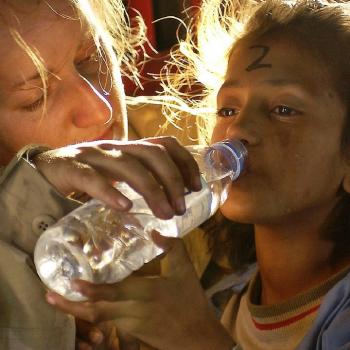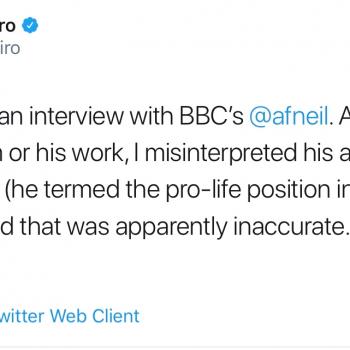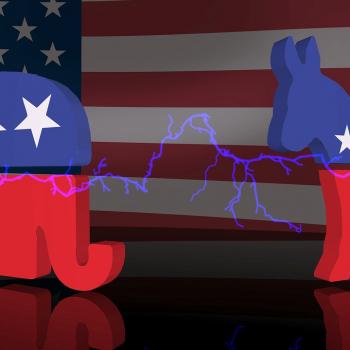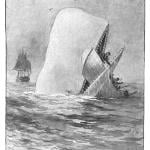
Image via Pixabay.
Ascience fiction author named Patrick S. Tomlinson asks a question that, I am told, “baffles abortion foes.” Raw Story has the story. What is this stumper of a question? you ask. Here it is: Would you save one thousand embryos or one child in a fire? Really? That’s it? This is the question that’s supposed to confound us? This is the question that gets Raw Story in a heat of excitement and Mr. Tomlinson many new followers on Twitter? Really?
Please. This question is a cliché. You probably heard something very much like it in high school. Perhaps your English 101 teacher gave it to you as a writing assignment. If two people are drowning, your mother and the president of the United States, and you have one life preserver, who do you throw it to?
You could make the question more interesting. Let’s say the two people are your mother and your father. You have one life preserver. What do you do?
Now, there are many ways one could answer this, but they’re not exactly complicated.
• Perhaps I know that one of the two individuals is a better swimmer than the other. I am going to throw the life preserver to the weaker swimmer.
• Or, I am going to throw the life preserver to the person who’s furthest from the boat, and row to the closest one in time to save him.
• Or, I am going to throw the life preserver to one of them at random, hop in the water, and attempt to save the other person.
In short, the answer is, you try to outsmart the limitations of your circumstances and save both. If you absolutely can’t save both, if you know you can’t save both, you make the best choice you can on the spur of the moment. And wise people—those who don’t concoct cliché parlor game questions in an effort to play gotcha—know they can not judge what anyone does in such an impossible situation. Nor can they draw any real conclusions from it.
Perhaps I throw the life preserver to my mother rather than the president of the United States because I know my mother, and I love my mother, and the president is a stranger to me. It’s an emotional response. (On the other hand, where the hell are the Secret Service?)
Mr. Tomlinson’s fictional trap has the same answer: You try to save both.
(Incidentally, there’s something altogether sketchy about the fact that these are embryos, rather than babies in a womb, and therefore were created in a morally illicit fashion in the first place. But let that go. You try to save both.)
But what if you can’t?
Mr. Tomlinson thinks he can draw some conclusions here, which in short are that pro-lifers don’t really believe that the unborn have equal value as the living.
They will never answer honestly, because we all instinctively understand the right answer is “A.” A human child is worth more than a thousand embryos. Or ten thousand. Or a million. Because they are not the same, not morally, not ethically, not biologically,” he wrote. “This question absolutely evicerates their arguments, and their refusal to answer confirms that they know it to be true.”
I suspect Mr. Tomlinson thinks that, if pro-lifers really believe what they say they do, they would view the thousand embryos as having greater value because there are a thousand of them, whereas there is only one child.
The first thing to point out is that this is not so. A single life—whether born or unborn—has equal value to a thousand or a million other lives. This is a theological point. Human life, made in the image of God, has worth individually, not en masse.
Here’s my second point, and it’s the most important in this context. If I were in this ridiculous situation, and if there was some special reason I could save either the embryos or the child in the fire, I’ll save the child in the fire. I say it frankly. I am not afraid of the answer.
And I will tell you why. (Well, one reason is that, if you remove the embryos from whatever situation they are being stored in, they are going to die anyway, so short of stopping the fire, you don’t have the choice to save them in the first place. This is the stupidness of Mr. Tomlinson’s question. But let’s put that to the side.) I will do so because the child in the fire looks human to me; the embryos don’t. It looks to be in suffering; the embryos don’t. My choice would be based entirely on my emotional reaction to the situation I was in.
And therein lies Mr. Tomlinson’s error. He thinks he can derive a conclusion about objective reality based on people’s subjective, emotional response in a hypothetical situation of peril in which they are forced to make Sophie’s choice. Sophie didn’t love the one child more than the other. Her one child that she rescued did not have any more value than the other child that she gave up to the Nazis.
Nor do the embryos have any less value than the child in the fire. One life or the other does not have less value somehow because I am up against human limits and have to make some choice. Playing Sophie’s choice about it doesn’t really reveal anything other than that you like to devise cliché trap questions. This is the kind of subject—do the born have more value or equal value than the unborn—that requires some sophisticated theological and philosophical argument, not too-clever-by-half parlor games that impress only Raw Story and the kind of people who frequent Twitter.












